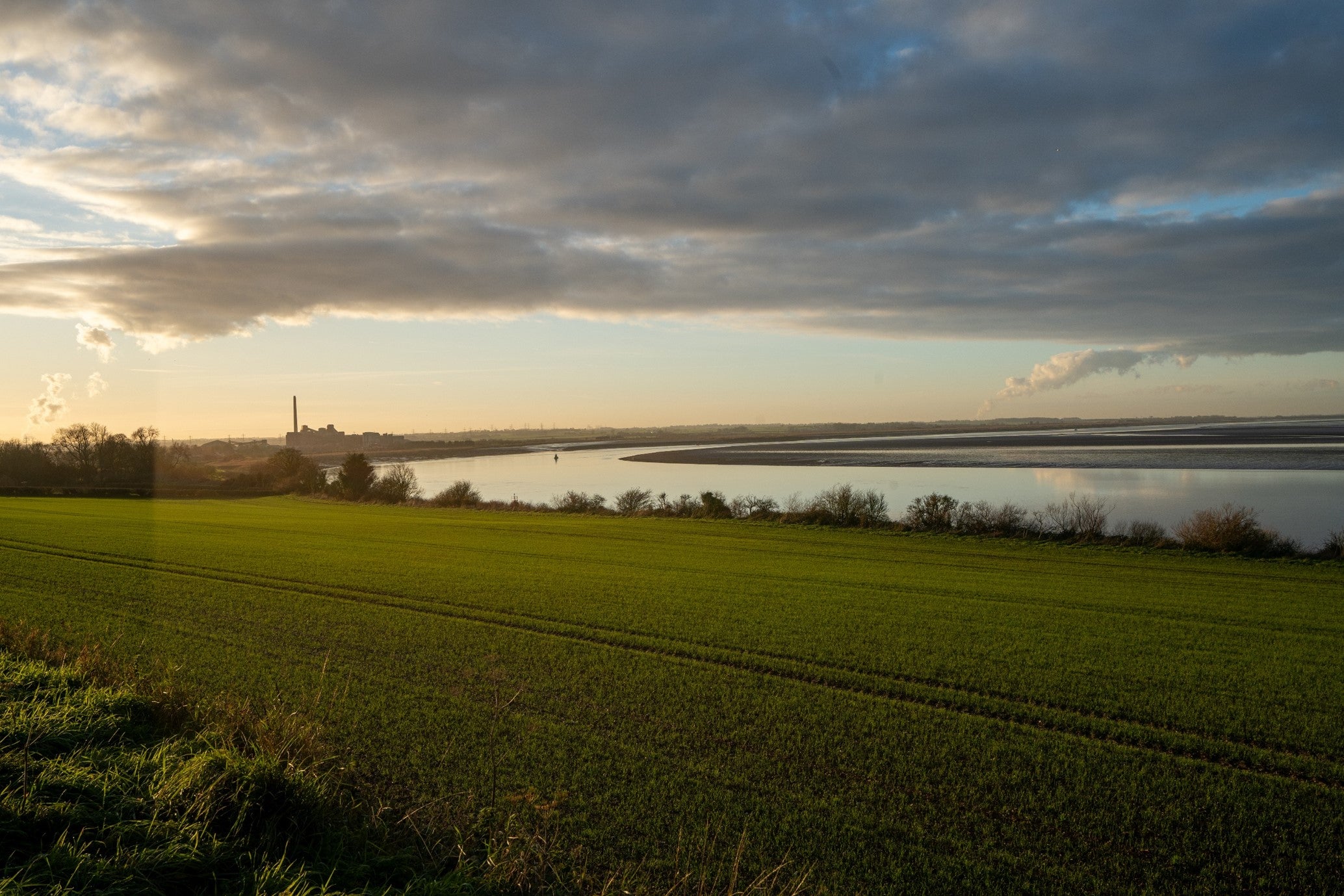This family friendly walk challenges the title of “England’s most boring county”. You’ll visit a beautiful nature reserve, the remains of a shipwreck, the UK’s longest single-span suspension bridge, the crossing point for the Vikings into England and a well preserved turf maze that is believed to date back to a medieval origin. This is a short walk but one which packs in plenty of sights. Get the full guide below as well as downloadable walking routes from Ordnance Survey and Komoot.
At a Glance
Difficulty: easy - flat walking on well maintained paths just be careful around Ferriby cliffs as the paths can be a bit steep
Distance: 8km/5miles
Total Ascent: 10m (it’s a very flat part of the county)
Est Time: 2 hours not including stops or breaks
Starting location: Waterside Road Car Park (DN18 5BE)
Dog friendly: yes along the River Humber path and on the turf maze but not within the nature reserve
Where is the River Humber?
On the east coast of England, the River Humber is a deepwater estuary that flows into the North Sea forming the boundary between Yorkshire and Lincolnshire. It is crossed by the spectacular Humber Bridge, built in 1981 and was the longest single span suspension bridge in the world when it first opened. The River Humber is an important trade route linking the UK with Europe as well as being one of the most important estuaries on the continent for migratory birds.

What is there to see along the River Humber?
In 2023, Lincolnshire was voted the most boring county in England but a walk in this area will show you how wrong that decision was and how much of a special area the River Humber is. This is a lovely walk with lots to see so wrap up warm in your Explore puffer jacket and matching So Snug bobble hat, grab a takeaway coffee from the visitor centre and set out on a walk along the banks of the River Humber.
The Humber Bridge and its banks
The Humber Bridge was officially opened in 1981 by the late Queen Elizabeth and dominates the skyline here. The walk heads straight under the Humber Bridge and its size is quite impressive. The bridge is open to pedestrians, cyclists and vehicles and stretches for around 1.4miles from one side to the other. It’s an incredible piece of engineering and was built after an initial idea of a permanent tunnel was rejected.

But, the reed banks underneath the Humber Bridge are the most special part. The careful management of the reed beds have meant that they are now home to an abundance of wildlife and rare birds have set up home here. They can often be seen flying above the reeds looking for insects. It’s an impressive balance of natural habitats for wildlife right under the shadow of an incredibly busy bridge. If you’re lucky, you might even spot the rapidly declining water vole. Due to the loss of its habitat, numbers are decreasing but thanks to local conservation efforts, numbers are currently stable for this little mammal.
Far Ings Nature Reserve
In the past, this was the site of clay pits used for producing bricks but now, the old pits have been transformed into large areas of diverse landscape and are visited by some of the UK’s rarest birds. This is a haven for wildlife so it’s worth spending some time wandering along the paths that meander within the nature reserve or camping out in the bird hides for a little while with your binoculars to see which birds you can spot.

Within the nature reserve there are three circular walks and each one is clearly signposted. The three trails vary in distance with the longest being two hours and the shortest just half an hour. Check out the walking trails within the nature reserve on their website.

Shipwreck and Ferriby cliffs
On the shorefront, an old shipwreck can be seen at low tide from the low cliff top path. This is the wreck of the Mary Maria, a three-masted wooden boat, thought to have been positioned in its location to form part of an old jetty in the 1920s. The wreck of the ship wasn’t discovered until 2002 during tidal scouring.

There are several ways down onto the pebbly beach but just be careful as some of these are steep. During spring and summer, this is a great place to see dragonflies, butterflies and wildflowers where chalk grassland meets woodland habitats. The shore here is also a spectacular place to watch the sunset if you time it right with the tide.

Ancient history of the River Humber
Around the edges of the River Humber are plenty of traces of ancient settlements. Historians have been able to date evidence right back to the Iron Age after the erosion of the chalk cliffs when artefacts and coins were revealed. In the nearby village of South Ferriby, excavation of a site used for a primary school, turned up a number of human skeletons in a crouched position, a sure sign of Iron Age traditions.
As well as this, the route passes alongside a Roman settlement where pottery was found. It is thought that these pots were transported by boats along the Humber to other Roman settlements.
The Vikings also used the River Humber to sail across the North Sea and up the estuary to reach York, slightly further north. In fact, the name Ferriby dates back to Viking days meaning “ferry”. Both the Vikings and Anglo Saxons would have settled on the north and south sides of the River Humber but it’s hard to imagine that now.
Is there public transport to the start of the walk?
Yes, there is a train station in Barton-on-Humber where it is only a 15 minute walk to the edge of the River Humber.
There is also a bus service that links Barton-on-Humber with both Hull and Scunthorpe. You can check the bus timetable here.
How long is the walk along the River Humber?
The walk is short and only two hours long but this doesn’t account for any stops or time to watch the wildlife within Far Ings Nature Reserve. On a nice day, it’s worthwhile spending half a day here and having lunch back at the visitor centre or the garden centre.
Is the River Humber walk family friendly?
Yes, the path is wide and well maintained and little legs will love exploring the wildlife hides and the pebbly beach front.
Are there facilities along the River Humber?
Yes, there are public toilets located within Waterside Road Car Park.
Along the walk, you can also visit the Humber Bridge Garden Centre where there is a restaurant, a selection of shops and facilities within the restaurant. The food here is lovely and the shop stocks lots of tasty treats and gifts.

Slightly further along the walk is the Far Ings Visitor Centre which has a cafe and toilets too.

Can you swim in the River Humber?
Yes but it’s really not recommended. The River Humber is a dangerous stretch of water and its tides and currents can be unpredictable. You can swim in the River Humber but only during a slack tide when the tide is weakest and you should have boat support with you. Ships also pass along the River Humber and under the Humber Bridge so this adds to the risk of swimming. If you want to swim in the River Humber, do it with an organised group for an event or charity. You can find these events online.
River Humber walk route and map
Download the Ordnance Survey route and map here.

- Parking at Waterside Road Car Park
- Head onto the riverside path and under the Humber Bridge. Just beyond here is the garden centre (look for the red brick path to the left) with a restaurant and multiple shops
- Far Ings Nature Reserve runs alongside the river bank after passing the Visitor Centre. You can take multiple entrances into the reserve and walk along the paths to see the wildlife and sit in the bird hides. The route follows the path back along the main river bank before heading away from the water and behind some farm buildings before rejoining at South Ferriby Cliff.
- This section of the walk heads onto the stony shore where there are a couple of steep paths down. This is best at low tide times as the remains of the shipwreck here will be visible.
The route back is linear, so you just need to retrace your steps back. Or, if you’re feeling peckish, I recommend a trip to the Hope and Anchor pub in South Ferriby. The food here is delicious (it features in the Michelin 2024 guide) and you can get the bus back to Barton-upon-Humber afterwards. Just be sure to check the bus timetable first and time your visit with it.
Komoot App
Have you ever tried Komoot? Komoot allows you to access routes planned by others or plan your own which you can then download to your phone to follow while you are out. Komoot is free to join and access and you can find the route for his walk here.
Other things to do around the River Humber
Waters’ Edge Country Park
Next to the parking at Waterside Road, you’ll find Waters’ Edge Country Park. It’s completely free to visit its 110 acres of wildlife and nature. Throughout the year they offer plenty of events with regular interactive displays too.

Julian’s Bower Turf Maze
If you have access to public transport, head down to Alkborough just a 15 minute drive away to see Julian’s Bower. This well preserved turf maze is thought to have originally been cut as far back as before 1220! It is one of the few surviving turf mazes that is believed to date back to the medieval age and cut by Benedictine monks. However, some historians believe that the maze was possibly first cut by the Romans and that the monks just reshaped it. Regardless, the turf maze is in a wonderful position, set high above Alkborough flats and overlooking the point at which the River Ouse, River Trent and the River Humber meet. It’s a great little spot and running around the maze is great fun for children and adults alike.

Alkborough Flats
If you’re a wildlife lover then Alkborough Flats is a fascinating project that’s worth visiting. The natural, flat setting is being used as a way of flooding prevention for nearby homes; river defences have been breached in turn creating new, flooded habitats perfect for thousands of wading birds. Check out this walk which includes a visit to the turf maze as well as through the flats.
The Viking Way
For a longer walking challenge, why not check out the Viking Way? This 149 mile route passes through Lincolnshire, Leicestershire and Rutland and was developed based on the influence of Vikings in the area. The route is marked clearly with a yellow Viking helmet and the whole walk has been split into 13 different sections so if you don’t feel up to the whole thing at once, you can do each section in your own time. You can find more information about the Viking Way on the Visit Lincolnshire website here.
For additional UK outdoor adventures, wild swimming, hiking routes and more, check my other blog posts here on MY URBAN TRAIL and follow me @Wild_0utdoors on Instagram.
Happy adventuring!
Izzy



